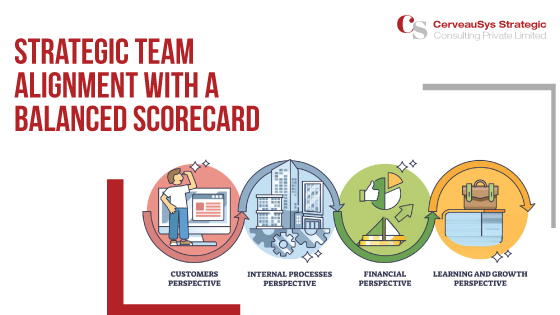How to Align Your Team with Your Business Strategy Using the Balanced Scorecard
Aligning your team with your business strategy is one of the most critical factors for organizational success. When every individual and team works collectively to fulfill the organization’s strategic objectives, it creates a sense of purpose, optimizes team performance, and accelerates business outcomes. However, achieving this alignment isn’t always simple. Often, the challenge lies in translating high-level strategic goals into actionable steps that resonate with every employee.
The solution comes in the form of the Balanced Scorecard (BSC). At CerveauSys Strategic, the Best Strategy and Management Consulting firm in Pune, we believe that BSC is a proven strategic framework that helps bridge the gap between strategy and execution. Let us help you explore how BSC can align your team with your business strategy and practical implementation methods and how aligning them can transform organizational performance.
What is the Balanced Scorecard and Why Does It Matter?
The Balanced Scorecard (BSC), introduced by Robert Kaplan and David Norton, is a strategic management framework that helps organizations translate broader goals into clearly defined actions. It goes beyond just financial metrics by integrating four perspectives to track and manage performance holistically.
These perspectives are:
- Financial Perspective: Measuring financial performance and profitability.
- Customer Perspective: Assessing how well the organization satisfies and retains its customers.
- Internal Process Perspective: Identifying critical business processes that must operate effectively.
- Learning & Growth Perspective: Evaluating employee development, innovation, and organizational capacity.
The Balanced Scorecard links these perspectives to create a cause-and-effect chain. For example, innovation enhances internal processes, which boosts customer satisfaction, ultimately improving financial outcomes. This interconnected approach gives leaders an accurate, well-rounded picture of organizational performance.
It’s also designed to foster better alignment across teams and departments. By providing measurable goals and defined outcomes, the BSC enables everyone to see how their work contributes to the larger business strategy. This level of clarity improves communication, collaboration, and accountability across the organization.
Steps to Align Your Team with Your Business Strategy Using the Balanced Scorecard
Strategizing is one thing, but execution is another. Below, we break down actionable steps to help apply the Balanced Scorecard to align your team with the company’s goals:
1. Define and Communicate Your Business Strategy Clearly
Your team cannot align with a strategy they don’t understand. Every successful BSC implementation begins with your leadership team defining a clear, actionable business strategy. Ensure your strategy highlights key components like your company’s vision (long-term aspirations), mission (what purpose you serve), and overarching strategic objectives.
Once these elements are defined, communicate them across the organization in consistent, digestible language. Avoid overly complex terminologies that may confuse employees. Use mechanisms such as interactive town halls, workshops, and departmental meetings to make the strategy relevant to employees at every level.
By ensuring your communication is two-way, you help employees see their role in contributing to your company’s larger mission while allowing them to voice insights or concerns.
2. Build a Robust Balanced Scorecard Framework
The BSC framework is the centerpiece that bridges your strategy to measurable goals. To start, break your strategic objectives into the four perspectives:
Financial Perspective:
Define what financial success means within your organization. For instance, are you looking to grow revenue, maximize efficiency, or improve margins?
Customer Perspective:
Customer satisfaction is the foundation of business sustainability. Identify how you will measure customer loyalty, satisfaction, and growth.
Internal Process Perspective
Pinpoint internal processes critical to achieving success. Is it time optimization, process quality, or technical efficiency? Example objective: Reduce supply chain lead time from 14 days to 7 days.
Learning & Growth Perspective
Identify areas to enhance organizational capabilities, upskill employees, or innovate. A supportive culture within the workforce is key here.
Detail every strategic metric to ensure clarity for every team involved. Assign KPIs and track performance consistently.
3. Cascade Organizational Goals to Every Team and Individual
Alignment works best when cascading becomes part of the process. Organizational goals should be broken down into actionable targets for each department and team. For instance:
- The company’s objective of improving operational efficiency could be cascaded to engineering teams to improve design time by 20%.
- Marketing could focus on delivering personalized content campaigns to align with the customer retention goal.
Use cascading frameworks to ensure accountability at all levels. When teams see their role in achieving an organization’s major goal, they become more motivated to perform better.
4. Measure Success Through KPIs and Motivate Teams
Without measurable performance indicators, goals are only aspirations. Link team activities to clear Key Performance Indicators (KPIs) that show progress. For example, the KPI for marketing could be increase in unique leads or conversion rates, while operational teams may track downtime reductions.
Simultaneously, motivate employees with incentive programs. Each milestone achieved could include team recognition, financial rewards, or developmental opportunities. When success leads to visible rewards, employees remain more engaged and take greater ownership of their work.
5. Foster Inter-Team Collaboration
Alignment happens best when collaboration replaces competition. Use BSC-driven goals to connect teams that must work together to address cross-functional challenges. For example, customer retention initiatives might blend marketing, production, and customer support teams as one united force.
Leverage activities like cross-departmental projects, brainstorming sessions, or even informal channels to foster collective successes. Encouraging this transparency eliminates silos and creates smoother workflow execution.
6. Integrate Technology to Monitor Implementation
Digital solutions help track Balanced Scorecard performance more effectively. Deploy tools such as performance dashboards, Balanced Scorecard apps, or integrated analytics platforms to score outcomes. These platforms provide automated tracking of KPIs, making the monitoring process seamless for leaders.
By enabling real-time reports, these tools allow organizations to detect issues instantly and realign accordingly.
7. Adapt Regular Feedback into Continuous Improvement
Use quarterly reviews or comprehensive feedback systems to discuss progress made toward the Balanced Scorecard objectives. Collect insights from both leadership teams and employees, and use the data to refine strategies. Constant reevaluation fosters agility, allowing you to weave in-market changes as necessary without displacing organizational goals.
The Bottom Line
Implementing the Balanced Scorecard is one of the most effective ways to align your team with your business strategy, creating an environment where your workforce operates with clarity and unity of purpose. However, deploying this tool strategically requires guidance from consultants who understand its nuances.
At CerveauSys Strategic, the Best Strategy and Management Consulting firm in Pune, we specialize in creating tailored Balanced Scorecard frameworks to ensure seamless alignment between strategy and execution. Whether you’re a growing organization refining your strategic plan or a large corporation enhancing performance metrics, our expert consulting team ensures high-impact results for your business.
Connect with us today to learn how the Balanced Scorecard can help your organization achieve lasting success!



